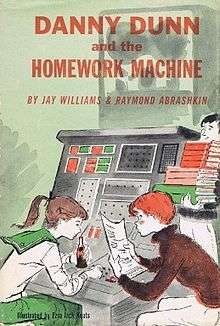Danny Dunn and the Homework Machine
Danny Dunn and the Homework Machine is the third novel in the Danny Dunn series of juvenile science fiction/adventure books written by Raymond Abrashkin and Jay Williams. The book is "about a boy who invents a machine to do his homework for him only to be tricked into doing more with his spare time".[1]
 First edition | |
| Author | Raymond Abrashkin Jay Williams |
|---|---|
| Illustrator | Ezra Jack Keats |
| Language | English |
| Series | Danny Dunn |
| Genre | Science fiction |
| Published | 1958 |
| Pages | 141 |
| OCLC | 302827 |
| Preceded by | Danny Dunn on a Desert Island |
| Followed by | Danny Dunn and the Weather Machine |
The book was first published in 1958 and originally illustrated by Ezra Jack Keats. This is the first novel in the series to feature Irene.
Plot
Danny uses a computer that Professor Bullfinch has created for NASA to prepare his homework, despite Professor Bullfinch's warning that Danny is to leave the machine alone. With his friend Joe Pearson and his new neighbor, Irene Miller, Danny has some success with the machine before it is sabotaged. Danny figures out what is wrong with the machine and corrects the problem. Danny's teacher also learns about the machine, and has her ideas for the Homework Champions. Once she finds out, she thinks of a way to trick the kids.
Current science
The "homework machine" is in the style of the large mainframe computers of the 1950s, and one that uses paper punched cards. The concept of students using computers for research is common today; however, this computer was not merely a machine via which the drudgery of solving many three or four digit long division problems could be offloaded; it was also somehow able to accept "programming" of students' text books that enabled it to write reports on topics that were covered by the text books.
Miscellania
Amateur radio is used for the first (and possibly only) time in the series, with Danny and Irene attempting to get a homework question answered. The callsigns used would have been accurate for mid-western operators in that era but not for the mode used (shortwave). In any event, there was too much static and the kids resorted to opening the windows and talking across the alley.
Reception
Floyd C. Gale wrote in the August 1959 issue of Galaxy Science Fiction that the book was "another funful adventure".[2]
Editions
McGraw-Hill
- Paperback, 1958, illustrated by Ezra Jack Keats
- Hardback, 1958, illustrated by Ezra Jack Keats
- Hardback, 1960, illustrated by Ezra Jack Keats
MacDonald and Jane's
- Hardback, 1977, illustrated by Anne Mieke
Archway Books
- Paperback, 1979, #5 in their series
Pocket Books
- Paperback, 1983 reissue, illustrated by Ezra Jack Keats
Musical
Danny Dunn and the Homework Machine was turned into a musical children's album on both Golden Records (Golden LP 239) and Wonderland Records (WLP-338), with music composed by Julie Mandel.
References
- Koshy, Yohann (3 November 2017). "Kids These Days by Malcolm Harris — no free brunch". Financial Times. Retrieved 2019-09-28.
- Gale, Floyd C. (August 1959). "Galaxy's 5 Star Star Shelf". Galaxy Science Fiction. pp. 138–142. Retrieved June 14, 2014.
- "Danny Dunn and the Homework Machine". Scholastic Press. Retrieved November 15, 2010.
- "Books Illustrated by Keats". Ezra Jack Keats Foundation. Retrieved November 15, 2010.